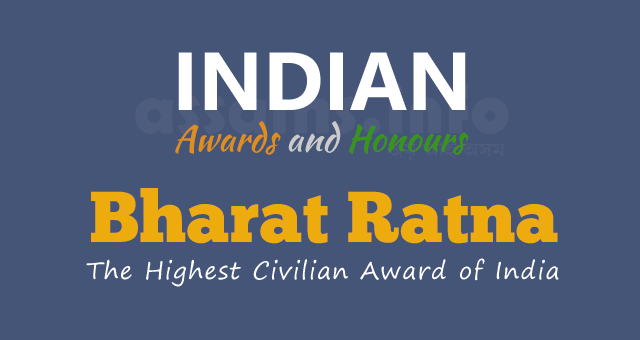Bharat Ratna is the highest civilian award conferred by the Government of India. It is awarded in recognition of exceptional service or performance of the highest order in any field. Bharat Ratna was instituted in the year 1954 and the first recipients were C. Rajagopalachari, Sarvepalli Radhakrishnan and C. V. Raman. Since then, many dignitaries from different fields has received this coveted award. It is not mandatory to award the Bharat Ratna every year. Also, the number of awards is restricted to a maximum of three in a single year. It may also be awarded posthumously.

Bharat Ratna Award details
Category: Indian Civilian Award
Significance: The highest civilian award in India.
Year of Institution: 1954
Frequency: No fixed frequency or it is not mandatory to confer annually.
Eligibility: Earlier the eligibility criteria was “Exceptional service towards the advancement of Art, Literature and Science, and also public service of the highest order”. Later in 2011, the eligibility criteria was modified. Now, this highest civilian award of India is presented in recognition of “exceptional service or performance of the highest order in any field of human endeavour.” Both male and female, belonging to any race, occupation or position are eligible, provided they meet the first criteria. It can also be presented posthumously.
Recommendation: No formal recommendations are required for Bharat Ratna. The Prime Minister of India recommends the name(s) of the recipient(s) to the President of India.
Conferment: Bharat Ratna is Given by the President of India. On conferment of the award, the recipient receives a medallion and a certificate (Sanad) signed by the President.
Medal: The shape of the medal is similar to a leaf of peepal tree (sacred fig). It is 59 mm long, 48 mm wide and 3.2mm thick. On front side, there is an embossed replica of the Sun with rays spreading out from the centre. Below the Sun, the words ‘Bharat Ratna’ are written in Devnagiri script. On the backside, there is an embossed National Emblem of India and the National motto “Satyameva Jayate” is written in Devnagiri. The medal is made from toned bronze. The Emblem, the Sun and the rim is made of platinum. The inscriptions are in burnished bronze. The Bharat Ratna medal is made by the India Government Mint in Kolkata.
Ribbon: The medal comes with a white riband , which is about 38 mm wide. The Bharat ratna medal is worn round the neck.
Monetary grants: The award does not carry any monetary grant.
Benefits for Bharat Ratna winners:
Through there is no monetary grants, the recipients of Bharat ratna enjoys some special benefits from the government services. For example:
- The recipients are treated as state guest when they travel within India.
- In the Govt table of precedence, they are listed in 7A which is right below the level of cabinet ministers and former primer ministers, but above the level of chief ministers and Governors of states (outside their native states).
- They are provided with Diplomatic passports.
- On their arrival at foreign shores, the Indian missions are required to provide proper facilitation to the winners.
- They also enjoy lifetime free executive class travel on Air India.
Winners of Bharat Ratna
Following is the list of personalities who were conferred with Bharat Ratna:
- 1954 – Chakravarti Rajagopalachari, Dr. Sarvepalli Radhakrishnan and Chandrasekhara Venkata Raman.
- 1955 – Dr. Bhagwan Das, Dr. Mokshagundam Visvesvaraya, Pandit Jawaharlal Nehru.
- 1957 – Pandit Govind Ballabh Pant.
- 1958 – Dr Dhondo Keshav Karve.
- 1961 – Dr. Bidhan Chandra Roy, Purushottam Das Tandon.
- 1962 – Dr. Rajendra Prasad.
- 1963 – Dr. Zakir Husain, Dr. Pandurang Vaman Kane.
- 1966 – Lal Bahadur Shastri (Posthumous).
- 1971 – Indira Gandhi.
- 1975 – Varahagiri Venkata Giri.
- 1976 – Kumaraswamy Kamaraj (Posthumous).
- 1980 – Mother Mary Teresa Bojaxhiu (Mother Teresa).
- 1983 – Acharya Vinoba Bhave (Posthumous).
- 1987 – Khan Abdul Ghaffar Khan.
- 1988 – Marudur Gopalan Ramachandran (Posthumous).
- 1990 – Dr. Bhim Rao Ramji Ambedkar (Posthumous), Dr. Nelson Rolihlahla Mandela.
- 1991 – Rajiv Gandhi (Posthumous), Sardar Vallabhbhai Patel (Posthumous), Morarji Desai.
- 1992 – Maulana Abul Kalam Azad (Posthumous), Jehangir Ratanji Dadabhai Tata, Satyajit Ray.
- 1997 – Gulzarilal Nanda, Aruna Asaf Ali (Posthumous) and Dr. A. P. J. Abdul Kalam.
- 1998 – Madurai Shanmukhavadivu Subbulakshmi and Chidambaram Subramaniam.
- 1999 – Jayaprakash Narayan (Posthumous), Professor Amartya Sen, Lokpriya Gopinath Bordoloi (Posthumous) and Pandit Ravi Shankar.
- 2001 – Lata Dinanath Mangeshkar and Ustad Bismillah Khan.
- 2009 – Pandit Bhimsen Gururaj Joshi.
- 2014 – Professor C. N. R. Rao and Sachin Ramesh Tendulkar.
- 2015 – Pandit Madan Mohan Malaviya and Atal Bihari Vajpayee
References:
- Ministry of Home Affairs, Government of India
